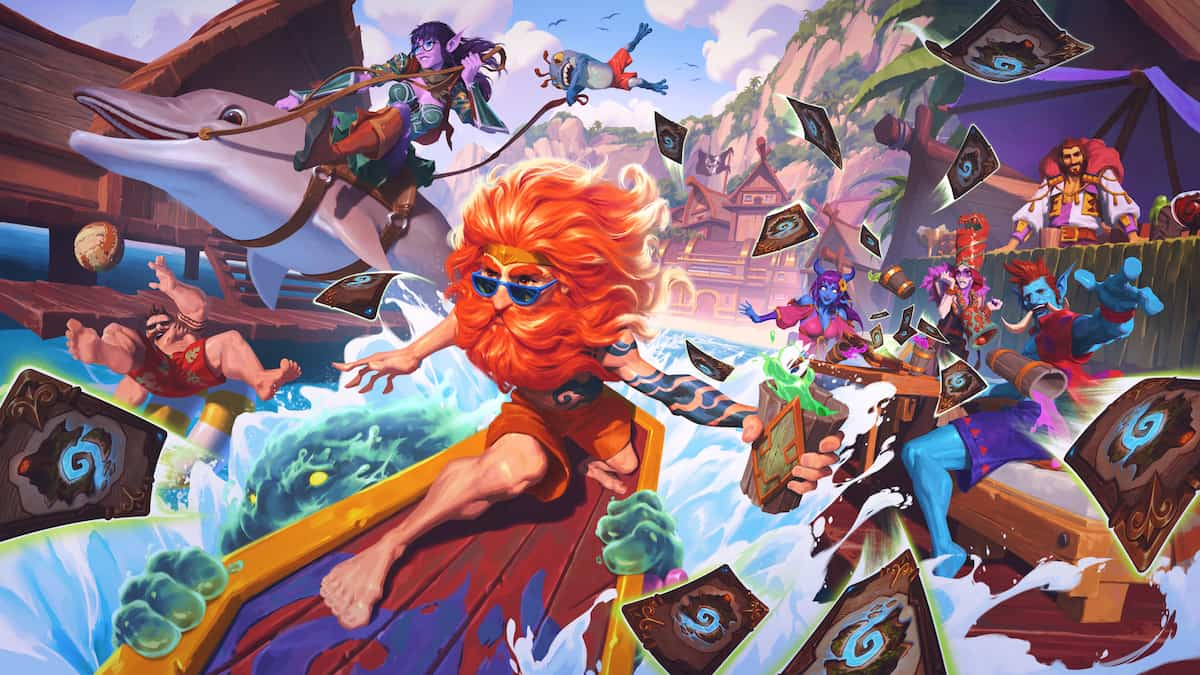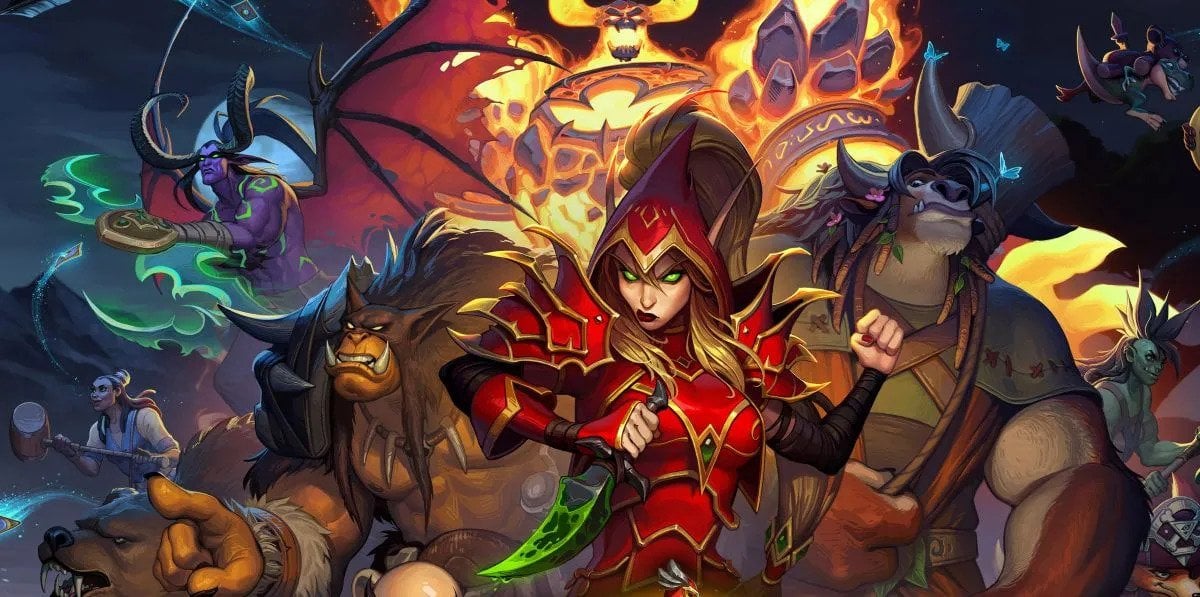When it comes to most trading card games, nothing lasts forever. In order to keep players buying cards and building new decks, TCG companies implore a format called Standard.
The Standard format in a TCG is easiest described as cards that are legal in competitive play. In order to keep the cards that are part of Standard fresh, numerous times a year the Standard format will have a rotation.
A rotation with regard to a format in a TCG means that a set of cards that were previously allowed to be used in Standard are now no longer usable. With three expansions leaving the Standard rotation of Hearthstone in April, its safe to say we’ll be seeing some fresh faces in our decks soon. We will also be losing some familiar faces that make up some of the top tier decks in the game. Here is a look at some of the meta-dictating cards leaving Hearthstone in April. These cards are all very strong choices, but the reader is advised not to craft them considering the short amount of time they have left in the format.
Carnivorous Cube

Carnivorous Cube is a card that is responsible for building an entirely new deck archetype for multiple classes. The card is a five cost, four attack, six health minion with a Battlecry that causes it to destroy a friendly minion. It also has a Deathrattle that makes it summon two copies of that minion.
In case your imagination isn’t already swirling with ideas of what this card brings to the table, here are a few different ways it was implemented in its lifespan. One of the first Cube decks to find success was Cube Warlock.
This deck runs the Warlock legendary Spiritsinger Umbra, a card with an effect that makes your minions Deathrattle trigger as soon as they’re summoned. Let’s say you have a Voidlord on the field, a 3/9 minion with taunt that summons three 1/3 minions with taunt when it dies. Now you play Carnivorous Cube on your Voidlord, if Umbra was on the field, you automatically get two Voidlords and a board full of 1/3 Taunt demons.
Warlock wasn’t the only class the cube found success in, however. More recently one of the top meta decks in the game has been Cube Hunter. This deck revolves around playing the Cube onto your Devilsaur Egg. The Egg has a Deathrattle that allows you to summon a 5/5 Dinosaur. Play the cube onto your egg and now you suddenly have a 5/5 Dinosaur and then two more 5/5 Dinos when your Cube dies.
These decks are very powerful and super fun, but they don’t have much time left in play. Unlike some of the decks mentioned in this article, Cube Warlock and Hunter literally won’t function as an archetype without this card. If you enjoy playing any Cube-related deck, you better get your fill before spring comes around.
The Lich King

Much like the real Lich King from World of Warcraft, Arthas in card form is a force to be reckoned with. The Lich King is an eight cost 8/8 Taunt minion that adds a random Death Knight card to your hand at the end of your turn.
Death Knight cards were introduced with the Frozen Throne expansion, primarily for the Lich King’s card affect. Lich King could generate one of eight cards that usually had a large tempo-swinging outcome. The cards generated by Lich King included removal cards like Death Coil, a two cost spell that allows you to deal five damage or restore five health, but Lich King could also generate things like Frostmourne, a weapon card.
Frostmourne is a seven cost weapon with five attack and three durability. Frostmourne’s Deathrattle allows you to summon every minion killed by it. This means if you kill a big value minion your opponent has out, such as Ragnaros, with Frostmourne, you now get a free Ragnaros when your weapon dies.
Given the amount of value jam packed into the card it’s easy to see why nearly every control deck in the game over the past year has ran a Lich King. Control Priest, Control Mage, Control Paladin, Control Lock, and Control Warrior have all seen iterations that included the Lich King in an eight drop spot. Outside of the value provided by the card’s actual affect, Lich King is a must for most control decks because it’s such a good decoy target for removal.
Since players know the amount of value that can be generated by allowing a Lich King to stay alive and feed cards to its owner, players will usually try to destroy an enemy Lich King as fast as possible. If you’re trying to force your opponent into spending removal, Lich King is a fantastic option. Enjoy the Lich King while you can, because Arthas’s reign ends when Frozen Throne leaves in April.
Frozen Throne Hero Cards

Hero cards were introduced in Knights of the Frozen Throne and are one of the most controversial additions to the game in its history. Hero cards usually have a high mana cost, award armor, have a powerful effect when they’re played, and they give you a more powerful Hero power.
Shortly after these cards were released they became must crafts for numerous decks. If you wanted to play a class, it was a pretty safe decision to go ahead and craft that class’s Hero card, even if you weren’t sure what deck you’d be playing yet. Many of the hero cards created their own archetype.

The Paladin Hero card Uther of the Ebon Blade was a way for the developers to literally force One Turn Kill Paladin into the game. Uther gives you a Hero power that allows you to summon one of four unique Horsemen, when you have all four on the board, you win the game.
Frost Lich Jaina practically invented Big Spell Mage. Jaina allows you to create a Frost Elemental any time your Hero power kills an opponent’s minion. She also gives your elementals Lifesteal, essentially giving you the ability to stay alive forever. Without Jaina, Big Spell Mage would essentially be a deck that revolved around keeping your opponent from killing you until you die from fatigue after running out of cards.
Every Hero card introduced with Frozen Throne created at least a couple of archetypes for its given class. It will be sad to see these cards removed from Standard play, but the thought of what Blizzard is brewing to take their place can be exciting.
Kingsbane

Kingsbane is probably the most powerful weapon card in the game. It is a one cost, one attack, three durability Rogue weapon that has a Deathrattle that shuffles it back into your deck and allows it to keep any enchantments.
Shortly after it was introduced to the game through Kobolds and Catacombs, Kingsbane became one of the strongest Rogue decks in existence. It was so strong at the launch of Rastakhan’s Rumble, its ability to have permanent lifesteal had to be nerfed. What is even more fascinating is after the Lifesteal nerf, Kingsbane Rogue remained extremely viable.
Kingsbane Rogue as a deck revolves around buffing your weapon and using it to smash your opponent in the face as much as possible. You’ll then want to use cards from your hand that allow you to retrieve the weapon from your deck as fast as possible.
Even Rogue decks that aren’t technically a Kingsbane-centric deck still run Kingsbane because of its infinite value. More recently, standard versions of Odd and Pirate Rogue run Kingsbane as back-up value to help with removal. Rogue is a class with an unclear future, as losing Kingsbane and its Hero card Valeria will mean you’ll be seeing totally fresh Rogue decks come April.

Having your favorite deck rotate out of Standard play can be a bummer when you think about all the time you’ve invested in mastering that deck. Looking at the situation through the scope of optimism can result in extreme hype, however. A new rotation can be one of the most exciting times to play a card game.
Players are forced to step outside of their comfort zone and to build never-before used decks in hopes of making something that is not only fun, but dominant. Since Hearthstone will be losing three entire sets in April, you can expect 2019 to be a fresh year in terms of deck diversity.
If you’re bummed about losing your favorite deck, buckle down study the most recent expansion Rastakhan’s Rumble. Think about the possibilities waiting in that expansion that will be unlocked by whatever new expansion we receive in the coming months. Enjoy your favorite current deck while you can, but don’t be so attached to it that you lose out on the excitement of a new Standard year.






Published: Jan 15, 2019 02:05 pm